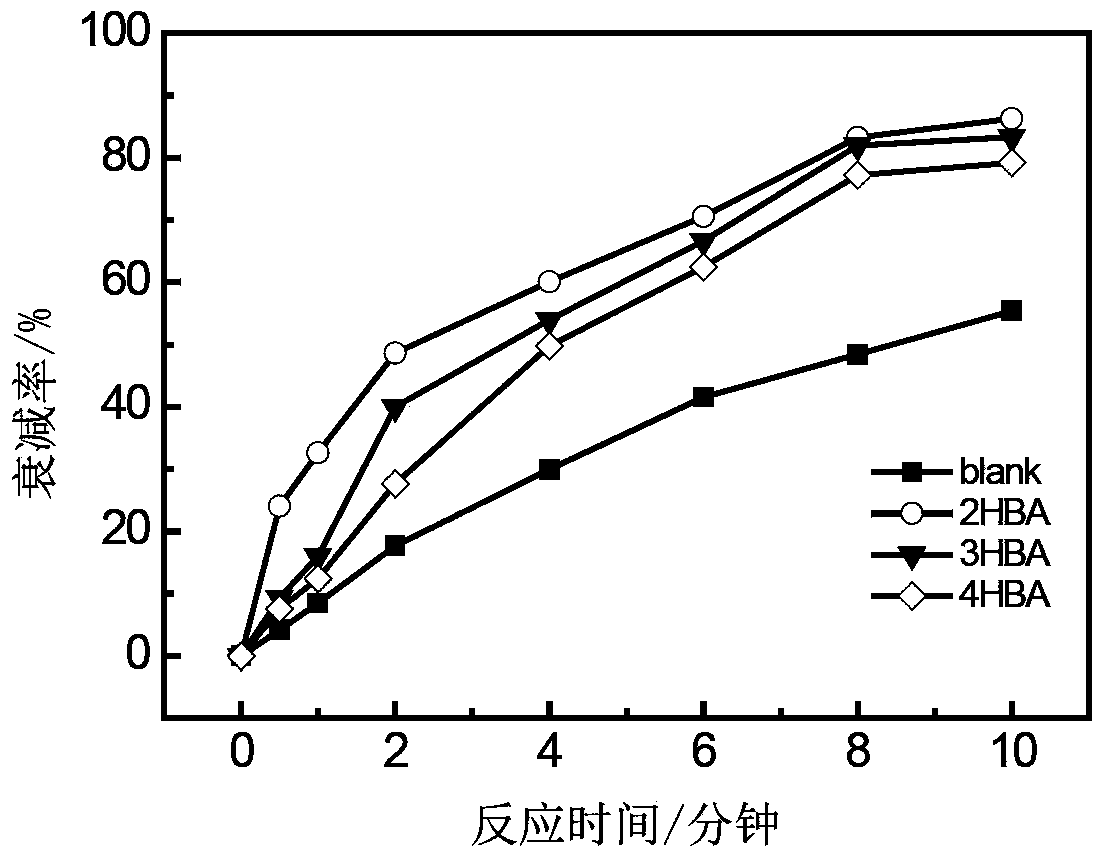Strengthening method for pollution removing by ozone acidic oxidation
An ozone and acid technology, applied in the field of strengthening ozone acid oxidation and decontamination, can solve the problems of high residual ozone concentration, low oxidation efficiency, low ozone utilization efficiency, etc. Effect
- Summary
- Abstract
- Description
- Claims
- Application Information
AI Technical Summary
Problems solved by technology
Method used
Image
Examples
Embodiment 1
[0040] A kind of enhanced ozone acid oxidation decontamination technology is realized through the following steps in the present embodiment: In the ozone contact pool, add ozone and strengthening agent simultaneously to the acidic water containing pollutant-2,4,6-trichlorophenol , and then uniformly stirred by hydraulic force to make it react. Wherein the ozone dosage is 20mg / L, the molar equivalent ratio of strengthening agent and ozone is 1:500, and hydraulic retention time is 10 minutes; O used in the present embodiment 3 There are many kinds of enhancers, namely salicylic acid, p-hydroxybenzoic acid, m-hydroxybenzoic acid, polyhydroxybenzoic acid, phthalic acid, naphthoic acid, anthracene formic acid, phenanthrene formic acid, diphenylformic acid, biphenyldicarboxylic acid, Phenol, aniline, anisole. And each of the above substances was tested as a strengthening agent one by one: the content of 2,4,6-trichlorophenol in the treated acid wastewater was greatly reduced, and t...
Embodiment 2
[0045] In this example, salicylic acid (2HBA), hydroxybenzoic acid (3HBA) and p-hydroxybenzoic acid (4HBA) were used as enhancers for testing and used according to the following steps: To target 2,4,6-trichlorophenol Add ozone water and ozone enhancer to the water body of pollutants, mechanically stir evenly, and complete the promotion of the ozone system after 5 minutes of reaction; the initial concentration of 2,4,6-trichlorophenol is 2.0mg / L, and the ozone concentration The concentration is 1.2mg / L, the molar ratio of enhancer to ozone is 1:30, the pH of the solution is 2.0, and the reaction temperature is 20°C. The removal effect of 2,4,6-trichlorophenol and the change of ozone decay rate are shown in figure 1 and figure 2 .
[0046] In this embodiment, the ozone is added in the form of ozone-saturated water.
[0047] In this embodiment, the strengthening agent significantly promoted the decomposition of ozone to produce hydroxyl radicals, the half-life of ozone was sh...
Embodiment 3
[0049] The difference between this embodiment and embodiment 2 is that the pH of the solution is 1.0. Other steps and parameters are the same as in Example 2.
[0050] In this example, salicylic acid (2HBA), hydroxybenzoic acid (3HBA) and p-hydroxybenzoic acid (4HBA) were used as enhancers to remove pollutants (2,4,6-trichlorophenol) in water after 10 minutes of reaction The removal rate increased by 26%, 24% and 30% in turn relative to the removal rate in the case of only using ozone.
PUM
| Property | Measurement | Unit |
|---|---|---|
| clearance rate | aaaaa | aaaaa |
Abstract
Description
Claims
Application Information
 Login to View More
Login to View More - R&D
- Intellectual Property
- Life Sciences
- Materials
- Tech Scout
- Unparalleled Data Quality
- Higher Quality Content
- 60% Fewer Hallucinations
Browse by: Latest US Patents, China's latest patents, Technical Efficacy Thesaurus, Application Domain, Technology Topic, Popular Technical Reports.
© 2025 PatSnap. All rights reserved.Legal|Privacy policy|Modern Slavery Act Transparency Statement|Sitemap|About US| Contact US: help@patsnap.com


